Content
Published:
This is an archived release.
More women victims of theft
Nearly 177 000 persons were registered as victims of over 192 000 offences reported to the police in 2012. This is 4 per cent and 4.5 per cent more than the year before respectively, and correlates with an increase in the number of women reported to be victims of theft in public places.
| 2012 | |
|---|---|
| Offences reported to the police, total | 393 674 |
| Offences reported to the police, with victims (persons) | 192 184 |
| Victims (persons) of offences reported to the police, total | 176 610 |
| Victims (persons) of offences for profit | 126 526 |
| Victims (persons) of offences for violence | 23 595 |
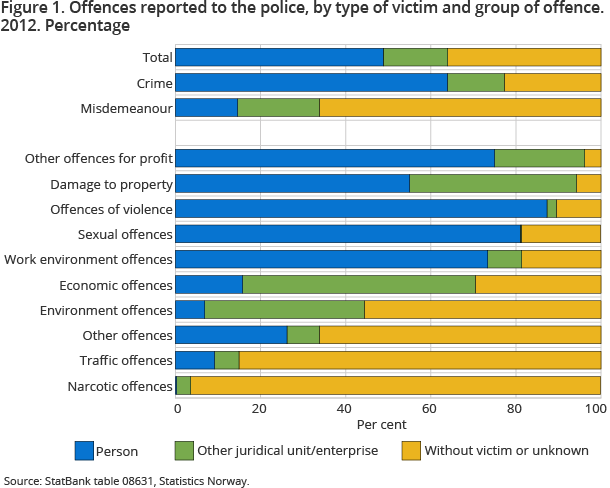
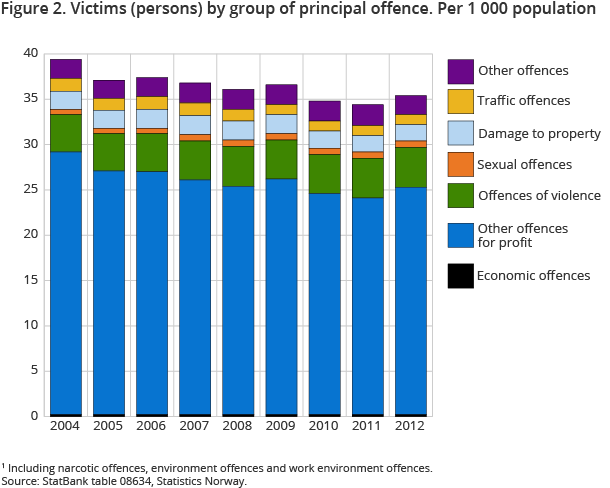
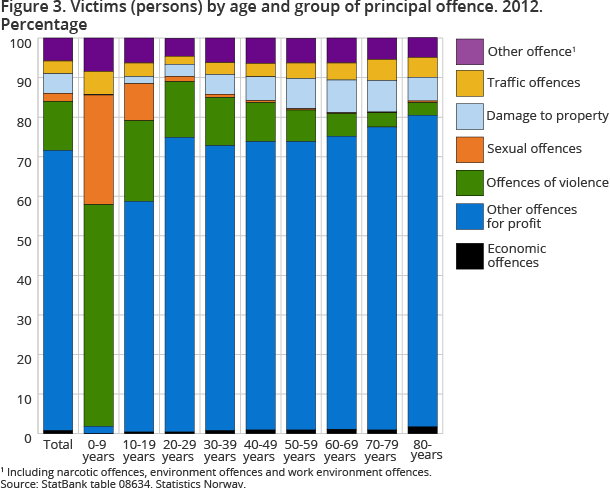
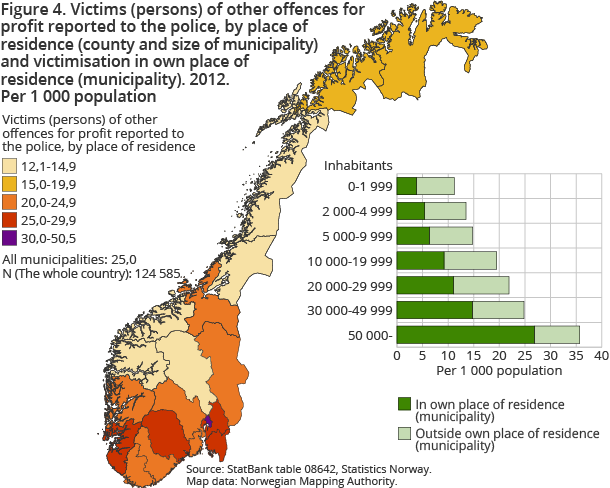
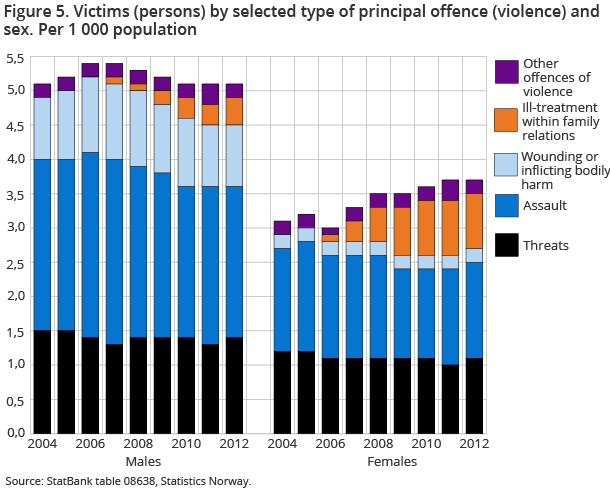
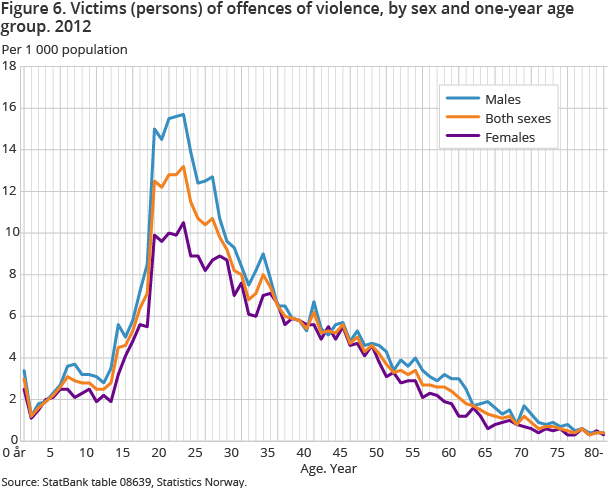
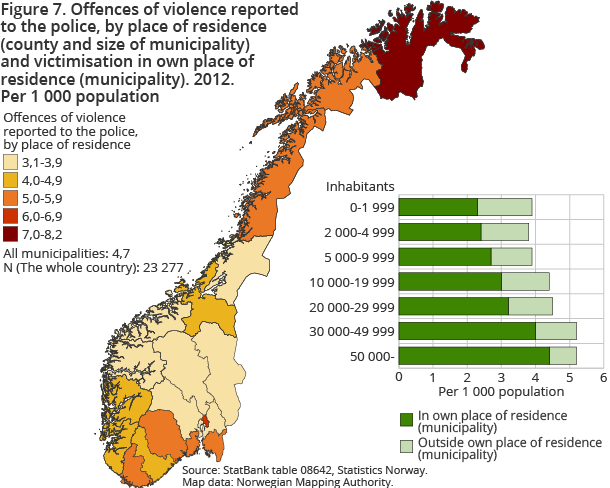
In 2012, almost 394 000 offences were reported to the police, of which more than 192 000 had a person registered as the victim. Out of all offences against persons, thefts and other offences for profit make up 70 per cent.
Enterprises or other juridical units were reported to be victims of 59 700 offences, and the number of offences with enterprises as victims is significantly smaller than in the previous three years. Compared to the year before, fewer enterprises are registered as victims in most groups of offences, and the decline is most significant in damage to property. In 2012, enterprises were registered as the victim of 38 200 offences for profit and 7 100 cases of damage to property, which is 19 per cent and 39 per cent fewer than in 2009 respectively.
In 2012, almost 142 000 offences were also reported to the police without a registered victim; 8 700 more than the year before. This is mainly due to more reported narcotics and traffic offences in 2012 than the year before. In 2012, these groups of offences constituted slightly more than two thirds of all offences reported to the police without a registered victim (see Figure 1).
More victims of thefts and other offences for profit
In total, nearly 135 000 offences for profit were registered against 126 500 persons in 2012. This is 6.7 per cent and 6.3 per cent more than the year before respectively, and on a par with 2009. If we take the population growth into account, this constitutes 4.9 per cent more victims of offences for profit in 2012 than in 2011. However, the volume of offences for profit per 1 000 population is still lower than during the years 2004-2009.
Out of all victims of offences reported to the police in 2012, 7 out of 10 were victims of one or more offences for profit, both for males and females. In total, almost 69 900 men and 56 700 women were registered as victims of offences for profit in 2012. For men, this is barely 2 per cent more than the previous year, while for women it constitutes an increase of more than 12 per cent from the year before. The increase in the number of female victims of offences for profit thereby corresponds to more than 80 per cent of the total increase of victims of these kinds of offences from 2011 to 2012.
More young adult victims
In all age levels from 17 years to 61 years, there are registered more victims of thefts and other offences for profit in 2012 than the year before. If we look at the different age groups, there are particularly many in the age group 20-29 years, with close to 35 000 victims of offences for profit in 2012. By comparison, 25 000 victims of offences for profit were registered in each of the age groups 30-39 years and 40-49 years. Furthermore, the increase from 2011 to 2012 is clearly highest in the age group 20-29 years, amounting to 11 per cent.
Oslo population most at risk
In 2012, 38 100 registered Oslo residents were reported as victims of crime, making up 6.2 per cent of the Oslo population. Of these, more than four out of five were victims of an offence for profit. The figure of 30 100 victims of offences for profit residing in Oslo is far higher than in other counties, and more than twice as many as in Akershus, with 14 800, which is the county with the second most victims of thefts and other offences for profit.
Even when taking into account that the population of Oslo is much larger than the other counties, it is clear that the population of the capital is at far greater risk of becoming a victim of an offence for profit. In 2012, 5 per cent of the Oslo population was registered as victims of one or more offences for profit, while the corresponding number for Sogn og Fjordane county was 1.2 per cent.
By size of municipality , we can see that the risk of becoming a victim of an offence for profit increases along with the size of the municipality of residence. In municipalities with a population of 50 000 people or more, there are 35.7 victims of offences for profit per 1 000 population. The corresponding figure for municipalities with a population of 2 000 or less is 11.2 (see Figure 4).
Increase in several types of theft
In 2012, over 125 000 persons were registered as victims of a theft or another offence for profit as the principal offence , which is over 7 400 more than the year before.
In 2012, 23 400 persons were registered as victims of aggravated larcenies in public places. This is 4 000 more than the year before, and this increase equals the whole of the increase in the category Other aggravated larceny. A total of 5 700 persons were registered as victims of minor larcenies from restaurants as a principal offence and 26 000 were in the category Other simple and minor larceny. This is just over 1 100 and 2 100 more than in 2011 respectively. Additionally, 6 800 victims of simple fraud (excluding aggravated fraud) were registered, which is 1 000 more than the year before. In contrast with previous years, there was also an increase in the number of persons registered as victims of simple and aggravated larcenies from houses or dwellings.
On the other hand, 18 800 persons were reported as victims of thefts of motor vehicles or thefts from means of transport in 2012, which is almost 10 per cent fewer than in 2011, thus extending a lengthy, declining trend for this type of theft.
12.5 per cent more women victims of other offences for profit
From the principal offence, 56 100 women were registered as victims of offences for profit in 2012. This is over 6 200 more than in 2011. Of these, 15 200 were victimised within the category Other aggravated larceny as the principal offence. Ninety-five per cent of these were victims of aggravated larcenies in public places, and nearly three out of four were victimised in Oslo . Additionally, 3 400 were victims of minor larcenies from restaurants, and in the more non-specified category Other simple and minor larceny, almost 12 000 were reported to be victims. In 2012, more than 3 000 women were also reported to be victims of simple fraud.
The total number of 33 600 women victimised in these kinds of offences is nearly 6 200 more than the year before, and equals the better part of the total increase in women reported as victims of offences for profit in 2012. The fact that so many more women have reported being victims of these kinds thefts and offences for profit is thus one of the main explanations for the total increase in victims (persons) of offences for profit – and also for the total increase in the number of victims from 2011 to 2012.
Women most victimised in aggravated larcenies in public places in Oslo
According to offences reported to the police in 2012, 10 900 women and 5 850 men were victims of aggravated larcenies in public places in Oslo. This is 2 800 more women and about the same number of men as in 2011. Among the victims of this kind of theft in Oslo, there were almost twice as many women as men.
Out of all victims of aggravated larcenies in public places in Oslo, 6 700 were registered as not residing in Oslo. Thus, 40 per cent of all the victims of this kind of theft in the capital were residents of a municipality other than Oslo.
Relatively stable volume of violence, but changes in types of violence
From the offences reported to the police in 2012, there were 4.7 offences of violence per 1 000 population. This is about the same level as in the period 2006-2011.
During this period, however, there has been a significant growth in population in Norway , and if we look at the specific types of violent offences, they vary considerably over time. The introduction of the law of ill-treatment within family relations in 2006 led to a change in registration practices for different types of violent offences, as well as a real increase in the number of offences and victims. The fact that 563 persons were registered as victims of violent offences in connection with the acts of terror of 22 July 2011 also affects the way we interpret the development of the statistics for violent crimes, both in the short and the long term (see Figure 5).
More victims of threats and other offences of violence
In 2012, a total of 23 600 individuals were registered as victims of one or more offences of violence, which is somewhat more than the year before, and almost 1 300 more than in 2010.
From the principal offence in 2012, over 6 200 persons were victims of threats, nearly 9 200 were victims of wounding or bodily harm, and more than 2 900 were victims of ill-treatment within family relations (including serious ill-treatment). For all these types of offences of violence, these levels are higher than the two previous years. The biggest increase was for the victims of threats, with 450 more victims in 2012 than in 2011.
The figure of 2 650 victims of grievous bodily harm, which is one of the more serious types of violent offences, is somewhat lower than in the previous two years. Additionally, there were 27 victims of murder and 50 victims of attempted murder in 2012, which is on a par with 2010.
Most male victims, but not for all types of violence
A total of 13 600 men and nearly 10 000 women were registered as victims of offences of violence in 2012. The share of men is thus almost 58 per cent; about the same as in 2011.
From the principal offence in 2012, 3 450 men and 2 770 women were reported to be victims of threats. This gender distribution among the victims of threats has been stable for the last three years. Most other types of violent offences have a large gender gap in relation to the breakdown of victims. Based on the principal offence, the male share is particularly high among the victims of grievous bodily harm (85 per cent) and wounding or bodily harm (61 per cent). In 2012, on the other hand, women amounted to 69 per cent of the victims of ill-treatment within family relations. Among the victims of sexual offences, the female share is even higher (86 per cent). Compared to these kinds of offences of violence, there are far more year-to-year variations among murder victims, of which there were 18 men and 9 women in 2012.
More children registered as victims of ill-treatment within family relations
A total of 2 917 persons were registered as victims of ill-treatment within family relations (including serious ill-treatment) in 2012, which is 107 more than the year before. This increase correlates with the 144 more children under the age of 10 who were reported as victims in 2012. These youngest victims thus make up a third of all victims of these kinds of offences in 2012, which is a larger share than in previous years.
From the principal offence in 2012, 904 men were registered as victims of ill-treatment within family relations. Among these, nearly nine out of ten are in the age range 0-19 years, and in total there were 143 more male victims than the year before. In the older age groups, there are far more women than men, but for the first time since introducing the ill-treatment legislation in 2006, there was no increase in the number of female victims of ill-treatment within family relations (see Figure 5).
Many young victims of violent offences
From offences reported to the police, the risk of being the victim of a violent offence is by far greatest for young adults, particularly those in their late teens and early 20s. This is especially the case for males, although there are also far more female victims of violent offences in this age range. In total, victims in the ages 18-23 years make up more than a fifth of all victims of one or more violent offence (see Figure 6).
The Finnmark population and the most populated municipalities most at risk
In 2012, 8.2 victims of violent offences were registered per 1 000 population in Finnmark county. This is significantly higher than among those residing in Oslo, which is second most at risk – with 6.3 victims of violent offences per 1 000 population. Compared to the population in the seven counties with the lowest share of victims of violent offences in 2012, those in Finnmark are more than twice as likely to be registered as a victim of a violent offence.
From the offences reported to the police in 2012, four out of five victims of violent offences or threats reported that the offence happened within the victim’s municipality of residence . However, the risk of a person being victimised in their own municipality of residence varies among the different groupings of size of municipality . The larger the population in a municipality, the larger the share of the population that reports falling victim to violent offences in this municipality.
This picture is partially reversed for those victimised within their own municipality of residence, where there is a larger share of victims of violent offences among those residing in the small municipalities than in the large ones. This means that, overall, there is no fully unambiguous correlation between the size of a person’s municipality and the risk of becoming a victim of a violent crime. As in earlier years, the residents in the municipalities with the largest populations are still most at risk. In 2012, 5.2 victims of violent offences were reported per 1 000 population among those residing in municipalities with more than 30 000 inhabitants. Correspondingly, there were fewer than 4 victims of violent crimes per 1 000 population in municipalities with a population of less than 10 000 (see Figure 7).
The statistics is now published as Offences and victims reported to the police.
Contact
-
Statistics Norway's Information Centre
E-mail: informasjon@ssb.no
tel.: (+47) 21 09 46 42
